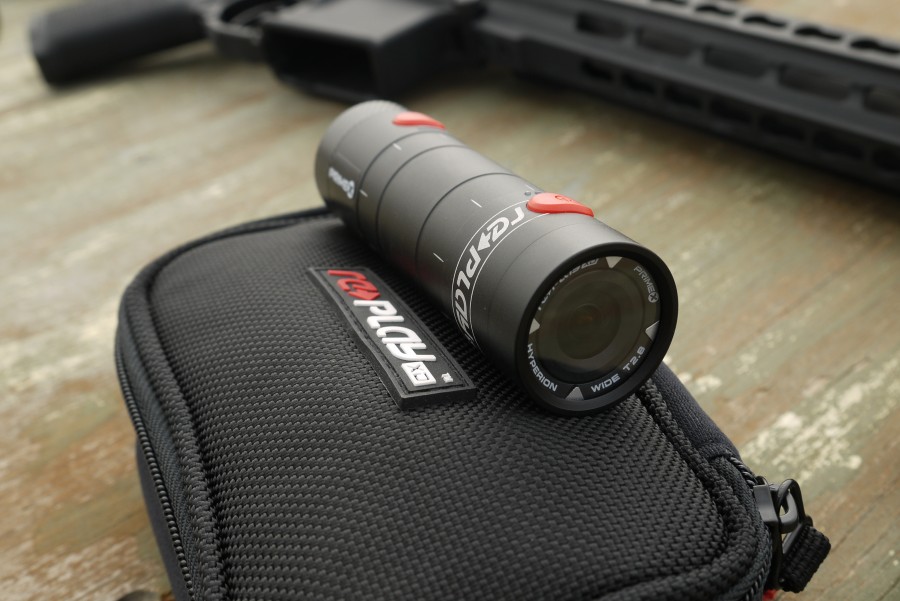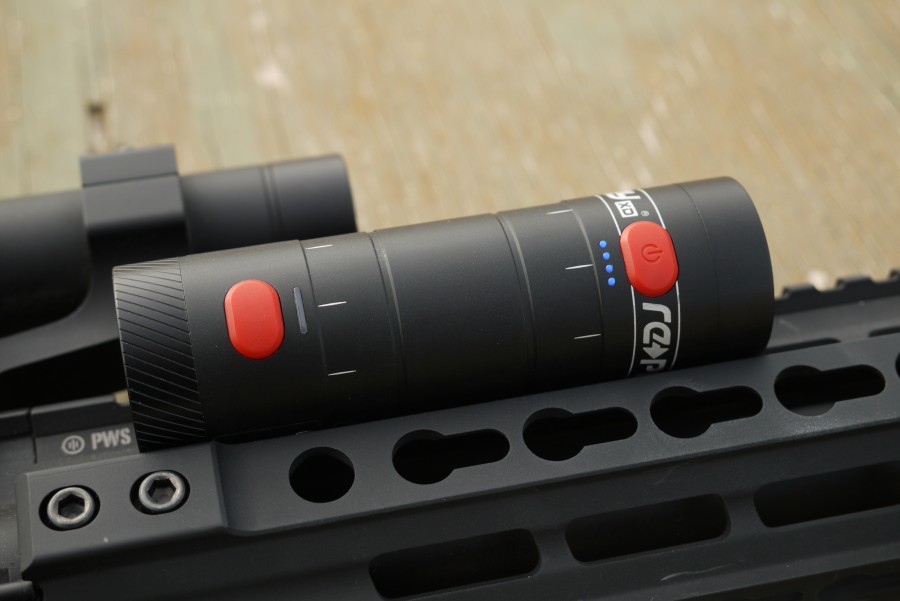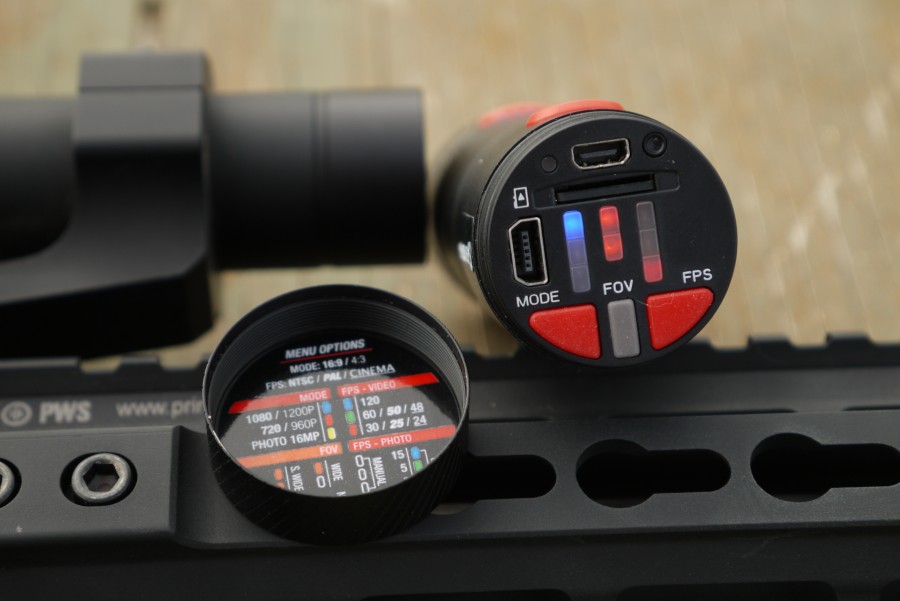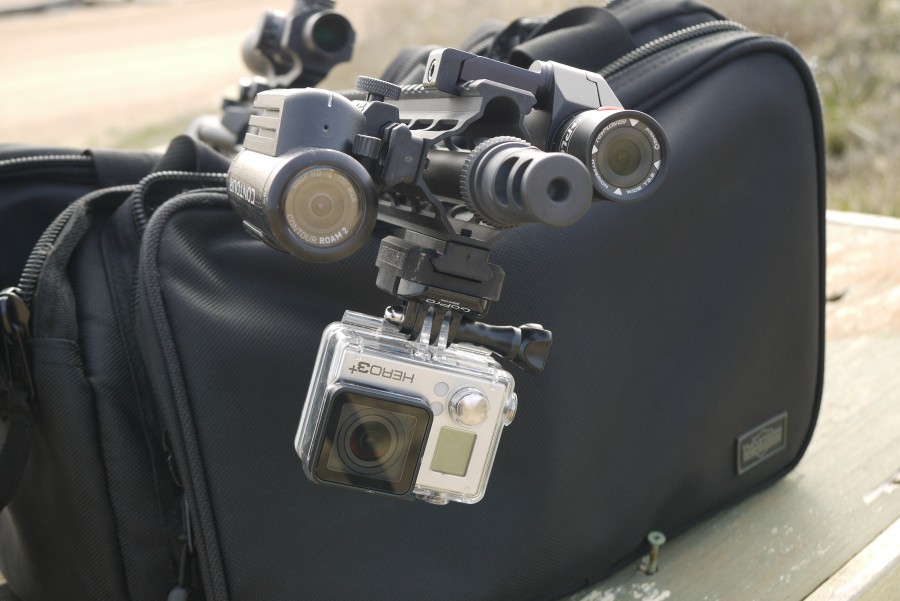I’ve watched over the last couple years as more and more competition shooters have started wearing and using “action cameras” to record their runs in competitions. It’s a smart practice, since not only can you later dissect your every move and find ways to improve but you can throw that video up on YouTube and make your sponsors happy — not to mention promoting the competition shooting sports. 3-gun is one of those sports where it’s a whole lot more fun and exciting watching from a first person view, and just having a camera following you doesn’t provide the same kind of heart-pumping video. Everywhere you look in firearms the same thing is happening, from hunters recording their kills to average Joes filming their range sessions. Finding the perfect camera for every situation is tough, but Replay XD might have hit the nail on the head with the Prime X Camera System.
Chris Dumm reviewed Replay’s previous venture into the action camera market about two years ago, and he gave it a glowing review. There were some things that could stand improvement though, and it looks like Replay has addressed every single issue. For the benefit of those who aren’t well versed in this market, though, let’s start from the beginning.
The “action camera” market is dominated by one name: GoPro. They were the ones to define the market and kick off the current craze of small high-definition cameras that can be stuck wherever you want to record your sport of choice. They’ve gotten to the point where the cameras are being widely used in the production of feature films and TV shows around the world, but there are some serious limitations. The form factor of the camera is decidedly box-like, which isn’t good for aerodynamics and generally makes you look like a tool if you try to wear it on your head.
That limitation has spawned a number of competitors, including the Contour ROAM 2 (which we reviewed as well) and this latest venture from Replay. The question of the day is whether the Replay XD Prime X is worth the cash, compared to the competition?
There’s no doubt that the Prime X is the smallest of the competitors. The camera is housed in a watertight cylinder, meaning that all the electrical bits are completely isolated from dust and water — very important for using it outside. The GoPro, by comparison, requires you to use a special housing if you want it to be waterproof.
The controls for this camera are minimalistic to say the least. There are two buttons on the outside, a power button and a record button. Both provide a tactile feedback that the camera is recording in the form of a series of vibrations and lights, which I really liked. On a noisy range it’s often not possible to hear the beep of a Contour camera turning on, but a vibration on your head is noticeable no matter the conditions. The lights also make a lot of sense — there are four lights to indicate battery status, and there’s one at the rear to tell you when the camera is recording. Like the minimalistic external controls on the Contour cameras it’s just enough to get the job done, but this configuration gives you a lot more useful information and lets you start recording just a little faster (as the camera is already “on”).
Unlike the Contour and previous Replay generations, this camera is dead simple to reconfigure in the field. Unscrew the rear cap and you have a series of LED indicator lights and some buttons to press. The key printed on the inside of the tailcap decodes what the cryptic symbols indicate, and with a couple seconds of prodding you can reconfigure the device to do whatever you want. Wide angle too wide? Want to turn down the resolution for longer recording time? How about changing to pictures only mode? All this can be done in a couple seconds, a major improvement over the older versions of the camera and the Contour approach.
This is one of the areas where the GoPro is still king, as the LCD display on the device (and especially on the newer models) gives you a lot more granular control over the configuration and many more options. But that comes with a price, not only in dollars but also in unit size.
If you don’t want to touch the buttons there’s also a way to configure and control the device over WiFi with an Apple or Android app on your phone, which is pretty much par for the course these days but still an appreciated feature.
The Prime X comes as a package from the factory with a caseload of mounts and accessories, and I mean that literally. The package includes a handy nylon carrying case, which neither the GoPro nor the Contour include in their packaging. Inside that case are a smattering of mounts for all different occasions, a lens cleaning cloth, and some other assorted camera related gubbins.
Mounts for this camera clamp onto the center portion of the device, and use the two grooves running around the center to align themselves. There’s no mechanism to keep the camera from rotating though, so friction alone is what keeps it straight (or whatever the equivalent of “straight” is where you’ve stuck it). For putting the camera in awkward locations, this is pretty awesome. The GoPro needs a series of interconnecting brackets to let it swivel if the mounting isn’t level, and vibrations can multiply in those brackets making the picture unstable. The Contour camera only has two mounting slots, one on either side, meaning whatever you’re sticking it on better be level enough for your purpose. With the Prime X, you can mount this on a 45 degree slope and rotate it level without any added contraptions.
The interface for most of the mounts on the Prime X is similar to the GoPro in that the camera is attached to one piece of plastic, and it slides into a housing that can be stuck almost anywhere. The ones that come in the kit are mostly adhesive based, but there are other options available for everything from a suction cup mount to a pro video camera mount. Inserting and removing the camera from that mount is easy as pie, and can be done single-handed without looking while flying a small plane through turbulent air. Ask me how I know.
Speaking of mounts, the mounting options for sticking the Prime X on firearms are hands down the best out there.
This is the rig I used to film the testing video (a little further down the page) comparing the image quality. You can probably start to see some of the issues.
With the GoPro, the boxy design and the odd interface mean that the camera sticks out nearly a full mile from the top of the rail. It’s great for getting sharp images and crystal clear 4k video, but when you’re trying to run a 3-gun competition or go hunting on the woods that tends to stick out a bit and get snagged on various things. Not really ideal.
The Contour (on the left) has a dedicated Picatinny mount that is available from the factory, which is a huge plus. The problem is that you’re very limited in what you can do. You can either mount it straight forward along the rail, or straight back. There’s no way to swivel it around to meet your needs. It also similarly sticks out a bit from the top of the rail, but not really enough to be worrisome.
The Prime X also has a dedicated Picatinny mount available from the factory, but unlike the GoPro or the Contour it looks like someone put more than five seconds of thought into the thing.
The design of the mount allows the camera to hug the rail very tightly, minimizing the profile of the camera and keeping the gun as slick as possible. It also features another nifty consideration: a set of teeth. The mount and the rail adapter can be rotated independently of each other, meaning you can set the camera to record at any angle you want. It’s a well thought out and useful solution to the problem of mounting a camera on a gun, and I really like it.
On paper, the Prime X seems to be a winner. Smaller and slimmer than a GoPro so you don’t have to worry about catching it on stuff. Easier to configure on the fly than a Contour. And with better controls and feedback than either. But what about how it works in the field? To answer that question I took it to the range with the competition, strapped it to my gun, and took it for a spin.
The results are pretty definitive. The Contour is the clear loser, with poor resolution and low light performance. The GoPro is the best looking of the three, but the form factor kicks it down a couple notches. And as for the Replay XD Prime X, the camera’s picture clarity is slightly lower than the GoPro (at 1080p 60fps) but definitely acceptable. And given the much improved form factor, I think its the winner.
As for how the camera works if you mount it to your head, I went out and tested that as well. Albeit in a slightly different environment than normal.
In my opinion, the Replay XD Prime X camera system is the best currently on the market for action cameras. The GoPro has all the bells and whistles that you’d need for really spectacular looking video, but that comes with a price tag commensurate with the quality as well as a really remarkably awkward mounting system. The Prime X is easy to configure, easy to use, and provides results that are good enough for any application. Plus, their rail mount is the best in the industry, and you don’t look like a complete tool when you use it strapped to your head or on your gun. Which is a huge consideration, since if you’re running a camera while shooting you probably care very much about how you look and not just how well you shoot — a valid concern these days.
Will the Prime X replace the trio of GoPro cameras in my camera bag? Probably not — those models still serve a purpose. But for attaching to guns or people, the only reason I’d go with a Contour would be price. The latest Contour camera clocks in at $199.99, while the Prime X will run you about $299.99. Then again, their smaller version (the older 1080 “mini”) is only $139.99, so I might just stick with that one instead. Actually, speaking of using the camera, this is the camera we used to record the video footage from the Charlie Hebdo simulation a month or so back.
SUMMARY:
Resolution: 16 MP (4608 x 3456) CMOS Sensor
- 1920 x 1080, up to 60 fps
- 1600 x 1200, up to 60 fps
- 1280 x 960, up to 60 fps
- 1280 x 720, up to 120 fps
- 848 x 480, up to 240 fps
- 640 x 480, up to 240 fps
- 16 MP JPEG Photo 4608 x 3456
- 14 MP JPEG Photo 4608 x 3072
- 12 MP JPEG Photo 4608 x 2592
Display: Live view over WiFi or HDMI output from the camera
Size: 1.18″ x 3.8″
Weight: 3.5 oz.
Lens: Hyperion CinePrime X Lens, T2.8 / ƒ/2.7 Natural Wide Angle
Price: $299 (Picatinny mount +$78.98)
Accessories: Tons of them; check the Replay website.
RATINGS (out of five stars):
Resolution * * * * *
Full 1080p, which is good enough for anyone these days. GoPro has 4k available, but unless you’re made of 10TB hard drives then you probably don’t need that quite yet.
Features * * * * *
Easy to use programming interface, easy to use mounting options, and great production quality.
Size/Weight * * * * *
Tiny and weightless.
Ease Of Use * * * * *
You can change anything you want with the push of a couple buttons.
Overall * * * * *
I think its swell.











Dude! The “prop turning backward” effect was just too cool. Good review!
And those scimitar blades — one would think you had stolen the prop off a C-130J or whatever the latest model is.
It’s really not an effect. It’s a byproduct of the rolling shutter in the camera and a frame rate that’s too slow to keep up with the motion of the prop. Shooting at 60fps it’s less noticeable and even less at 120fps. That backwards look is just the sign of a cheap camera.
Good review. I’ve been thinking about small cameras like this for a while now. The 1080 mini looks like exactly what I am looking for.
Interesting. I have to see how I might mount this onto my O/U Field Clay gun so I can see how I am missing certain sym doubles. I am cross eye shooter and I would like to know on some shots what I am seeing versus where the gun is point to understand my mistakes.
How do these cameras stand up to the intense shock and vibration when mounted to firearms?
These cameras can take being smashed between two cars on the race track and hit at 80mph with just scratches and maybe a lens replacement. Mine also handles my AR just fine.
If you want to see how tough these RePlay cameras are, just go look at what Rob Ski puts them through in some of his AK torcher tests. I know because I sent the camera to him! http://www.onboard.tv
Is a “torcher” test where you test to see if the rifle will shoot while it’s on fire?
typing on my iPad
Do these or any similar cameras have WiFi streaming capabilities to allow real-time uploading?
GoPro does.
The Contour+2 will stream via Bluetooth to your phone or tablet, but you can’t stream directly to off-device storage. It’s handy when you’re adjusting angles or rotating the lens on the Contour to get the horizon level. You can also turn recording on & off via Bluetooth.
But in order to get the video off the device, you have to pull the memory card or plug the camera into your computer.
Great review Nick… did you try it mounted to ear pro? If so, which mount did you use for that and how did it work?
Thanks!
Hi Matt,
On my Howard Leight Impact Sports, I use the heimlock mount attached to a convex adhesive mount that stays on my earmuffs. Then I can just take it in and out of the tray easily and it always goes in the same spot.
I’m mostly glad to see Contour is back in business. The market needs competition.
Contour was never competition, today they’re run buy a bunch of bean counters who can’t figure out social media. It’s a company selling three year old camera tech at today’s prices. Few than a dozen of the original 60 employees came back to work for the new company. I would not expect them to be around much longer.
This review came just in time for me Nick!
Thanks!
-D
Looks like a nice piece of kit, but c’mon, $78 for the picatinny rail mount? Really? That can’t cost much more than $10 to $15 to make. You can get gun mounts for the GoPro for less than $30.
It wouldn’t be so bad if this was, say a scope mount that you’d keep for years. This, however is a piece of electronic doo-dadery that will be obsolete in a year compared to new things that come out. A couple of years ago, the Go Pro was the only real game in town and people who bought into that ecosystem have to essentially chuck it all if they decide to move to the Replay.
Who knows if in a couple of years, some whiz kid comes out with the next big thing in wearable cameras and now you need to chuck all the Replay gear to move to that unit.
Frankly, I’m tired of getting ripped off having to buy the accessories that should have come with the product to begin with or else should have been priced at a reasonable level.
The Picatinny rail mount is a $25-$30 piece of kit, nothing more. Replay would be smart if they came out with a SKU that included the camera and gun mount aimed specifically at shooters.
$78 is MSRP, I bought mine for 35 bucks from Office Depot, it works on all but the original Replay so its not something you toss next month when a new Replay comes out, you instead get the new camera and slap it in.
Hey man, loved your review! I own a Prime X and have to say, I really love the camera! I first saw the camera going through one of Canada’s leading supplier of operational equipment, Rampart International Corp. I needed a camera that was small, but still took great photos and videos. For such a small compact size, it can pack a punch. At 16mp, it took some very good quality photos. I’ve used it for snowboarding, and the filming was surprisingly good, but it took in a lot of noise because the mic is right underneath the lens. I’m glad they added windbreakers to the Prime X package, but I find you have to place it correctly to pick up some noise – fully blocked and the mic won’t pick up anything. I find that, when I was recording, there was a constant wizzing sound. I’m not sure if it’s because the camera was recording – I have yet to find out what the cause of it was. Have you had that problem? I was just wondering, what kind of head mount did you use?
Comments are closed.